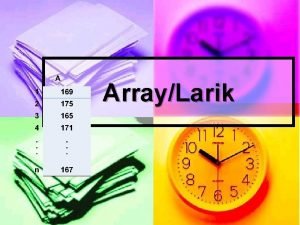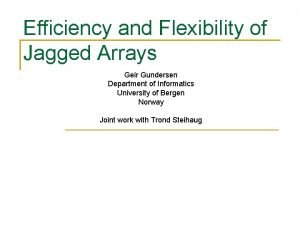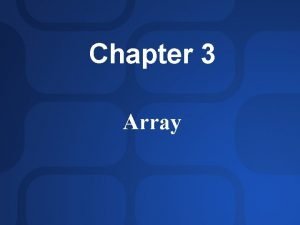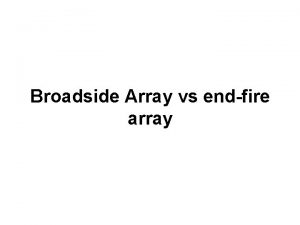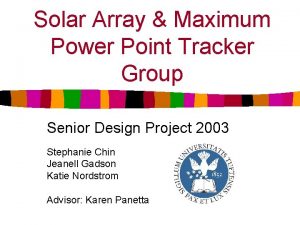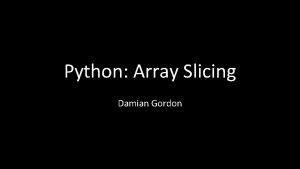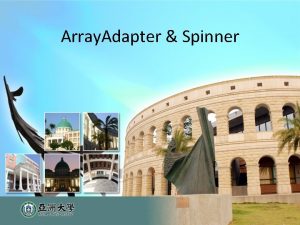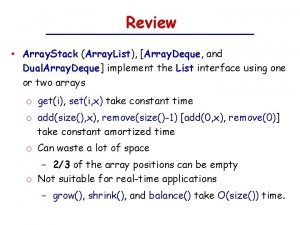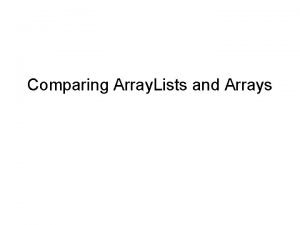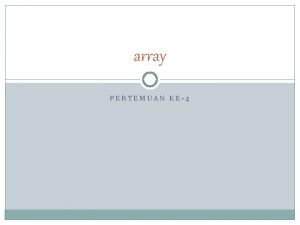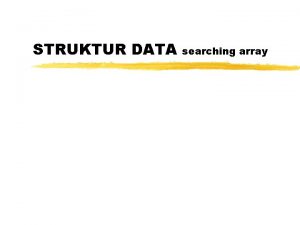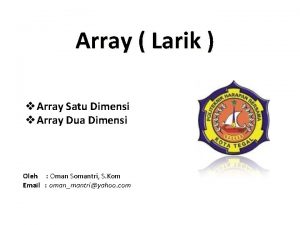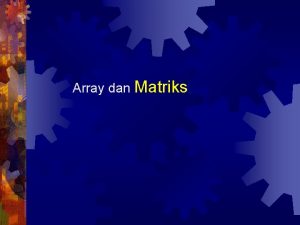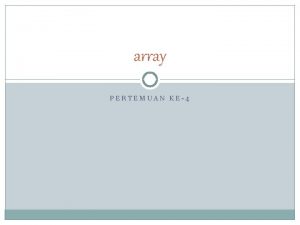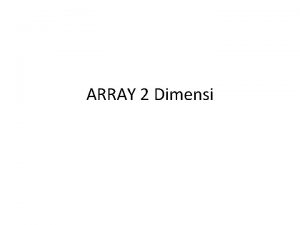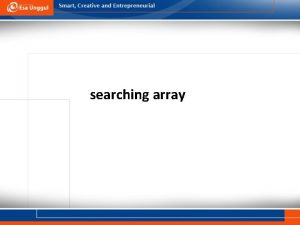e SMA the SMAJCMTCSO array David J Wilner



























- Slides: 27

e. SMA: the SMA-JCMT-CSO array David J. Wilner (Harvard-Smithsonian Cf. A) HIA (Sub)Millimeter Observing Techniques Summer School August 14 -17, 2006 1

What is the SMA? • The SMA is a pathfinding instrument comprised of eight 6 meter antennas on Mauna Kea, HI, designed for high spatial and spectral resolution imaging in submillimeter atmospheric windows. • The SMA is now being used to study Solar System bodies, protoplanetary disks, star forming regions, evolved star envelopes, the Galactic Center, nearby galaxies, and ultraluminous galaxies at cosmological distances. The SMA is a collaborative project of the Smithsonian Astrophysical Observatory, part of the Harvard-Smithsonian Center for Astrophysics, and the Academia Sinica Institute of Astronomy and Astrophysics (Taiwan) 2

SMA and Pu’puli’ahu 3

Historical Perspective • 1984: SAO Study • (1992 -1998: CSO-JCMT) • 1994: OSDA U. Hawaii • 1996: ASIAA expansion +2 antennas (to 28 baselines) • 1999 -2003: antennas deployed to Mauna Kea • 2001: JCMT MOU (aim 2005) • 2004: first SMA science • 2006: >50 refereed papers 4

Specifications (and why) SMA Specifications Antennas: 8 antennas of 6 m diameter, 12 m rms surface cost + imaging speed + collecting area (~JCMT) Configurations: 24 pads in four rings baseline lengths 8 - 508 m, subarcsecond resolution, best 0. 1’’ Receivers: max 8 per antenna; 2 simultaneously full frequency coverage of atmospheric windows dual polarization; “high” & “low” for calibration 177 -256 GHz (8 in operation) 256 -360 GHz (8 in operation) 320 -420 GHz (start 2006), 420 -520 GHz (future? ) 600 -720 GHz (8 in operation) 780 -920 GHz (future? ) Correlator: 2 GHz bandwidth, up to 25 k. Hz resolution sensitivity, span/resolve extragalactic/galactic lines 5

Receiver Bands/Atmosphere 460 GHz 230 GHz 690 GHz 345 GHz 805 GHz 6

Antenna Stations 4 Nested Rings (Keto 1997) 4 Configurations – – Subcompact Compact Extended Very extended 7

Field of View/Resolution Frequency (GHz) Primary Beam FWHM 230 Spatial Resolution Compact Array Extended Array Very Ext. Array ~52” ~3” ~1” ~0. 4” 345 ~35” ~2” ~0. 7” ~0. 3” 690 ~17” ~1” ~0. 35” ~0. 15” 8

SMA Correlator LSB: 2 GHz = 24 x 82 MHz USB: 2 GHz = 24 x 82 MHz 10 GHz e. g. Orion-KL, Beuther et al. 9

Spectral Coverage/Resolution Velocity Resolution (km/s) Bandwidth 230 GHz 345 GHz 690 GHz Full Continuum 2 GHz / sideband 2600 1740 869 Standard Spectral Res. ~800 k. Hz 1 0. 7 0. 35 Maximum* Spectral Res. ~25 k. Hz 0. 03 0. 022 0. 01 10

Observing Information • SMA partner fractions Cf. A: ASIAA: If. A = 72: 15: 13 • ~ 20% of Cf. A time available to PI’s from worldwide astronomical community w/Cf. A collaboration • proposal deadlines on 6 month cycle (March/September) – next deadline: Sep 7, 2006 (for Nov-Apr) – last deadline: 80 proposals, 8/31 external PI proposals rated “A” • • multiple antenna configurations available dynamic queue scheduling according to weather RTDC archive, data in public domain after 15 months Calibration and Imaging: – MIR (OVRO)/Miriad and Miriad/AIPS 11

http: //sma 1. sma. hawaii. edu 12

http: //sma 1. sma. hawaii. edu • SMA Observer Center – – Current Call for Proposals Updated Status of Array Technical Capabilities Proposal Submission Facility Tools: • • Beam Calculator/Sensitivity Estimator Passband Visualization Submillimeter Calibrator List and Flux History Link to RTDC Archive Search One Stop Shopping for All Your SMA Needs 13

Beam Calculator/Sensitivity Estimator 14

Beam Calculator/Sensitivity Estimator 15

Passband Visualizer 16

Submillimeter Calibrator List 17

What is the e. SMA? • the e. SMA is a collaboration between the SMA, the JCMT, and the CSO, to join all three observatories into a single interferometer array • will operate part-time in 345 GHz atmospheric window JCMT 15 m CSO 10. 4 m SMA 8 x 6 m 18

Why? I. More Sensitivity • JCMT and CSO double the array collecting area • for each baseline • point source sensitivity • full track, dual pol, 345 GHz, pwv 1 mm, dec 30 SMA (8) e. SMA rms (cont) 0. 7 m. Jy 0. 4 m. Jy rms (1 MHz) 45 m. Jy 25 m. Jy 19

Why? II. More Resolution 20

Why? II. More Resolution • JCMT = pad 25 • CSO = pad 26 • longest baseline: 508 781 m • uniform weight beam @345 GHz 0. 31 x 0. 18 (49 o) 21

e. SMA Testing • • • 2005 May: SMA IF/LO equipment to JCMT 2005 Jul: first fringes SMA-JCMT (3 C 454. 3) 2005 Sep: SMA IF/LO equipment to CSO 2005 Oct: first fringes with SMA-JCMT-CSO 2005 Dec: attempt to measure baselines 2006: new receivers (to be) deployed – SMA: 320 -420 GHz, enables 2 pol. 320 -355 GHz – JCMT: refurbish Rx. W, 345 band, 2 pol, IF 4 -6 GHz – CSO: new 280 -420 GHz, 1(+) pol, IF 4 -6 GHz • 2007? science observations 22

First Fringes SMA-JCMT (267 GHz) 23

SMA-JCMT Orion-KL Spectra LSB (221 -222 GHz) USB (230 -231 GHz) 24

A few e. SMA Issues • • • different sky rotation of polarization baseline non-intersection of axes terms interfaces for SMA control of JCMT and CSO phase stable? (slew, focus, …) correlator modes – 8 SMA + CSO + JCMT = 45 baselines (1 pol) – 6 SMA + CSO + JCMT = 28 baselines (2 pol) • e. SMA baselines are all long (subarcec) – implications for SMA configuration(s)? • politics of time allocation 25

e. SMA Outlook • • no insurmountable technical problems (yet) on track for science observations in 2007 a lot of exciting science opportunities to get involved 26

Key People SMA Director. . . … Ray Blundell Technical. . . . . Bob Wilson Operations (Hilo). . . …. Ant Schinckel ASIAA. . . … Paul Ho 27
 Daniela wilner
Daniela wilner Larik+adalah
Larik+adalah Jagged array vs multidimensional array
Jagged array vs multidimensional array Sparse array adalah
Sparse array adalah Associative array vs indexed array
Associative array vs indexed array Array 1 dimensi dan multidimensi
Array 1 dimensi dan multidimensi Pin grid array and land grid array
Pin grid array and land grid array Difference between broadside array and endfire array
Difference between broadside array and endfire array Photovoltaic array maximum power point tracking array
Photovoltaic array maximum power point tracking array Contoh array
Contoh array Các châu lục và đại dương trên thế giới
Các châu lục và đại dương trên thế giới Thế nào là hệ số cao nhất
Thế nào là hệ số cao nhất Hệ hô hấp
Hệ hô hấp Tư thế ngồi viết
Tư thế ngồi viết Cái miệng xinh xinh thế chỉ nói điều hay thôi
Cái miệng xinh xinh thế chỉ nói điều hay thôi Hình ảnh bộ gõ cơ thể búng tay
Hình ảnh bộ gõ cơ thể búng tay đặc điểm cơ thể của người tối cổ
đặc điểm cơ thể của người tối cổ Cách giải mật thư tọa độ
Cách giải mật thư tọa độ Chụp phim tư thế worms-breton
Chụp phim tư thế worms-breton Tư thế ngồi viết
Tư thế ngồi viết ưu thế lai là gì
ưu thế lai là gì Thẻ vin
Thẻ vin Chó sói
Chó sói Thể thơ truyền thống
Thể thơ truyền thống Các châu lục và đại dương trên thế giới
Các châu lục và đại dương trên thế giới Từ ngữ thể hiện lòng nhân hậu
Từ ngữ thể hiện lòng nhân hậu Diễn thế sinh thái là
Diễn thế sinh thái là

